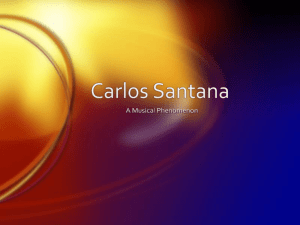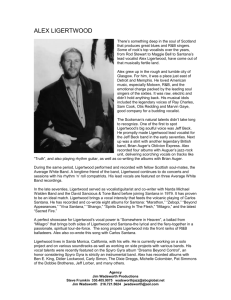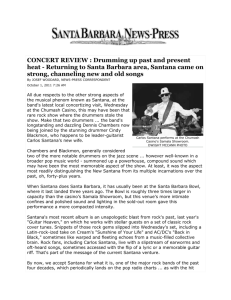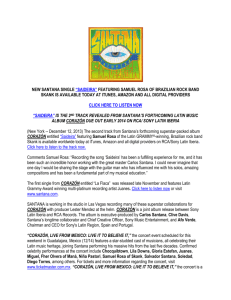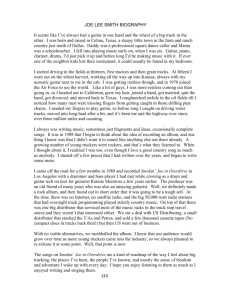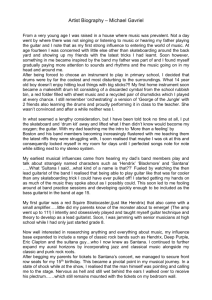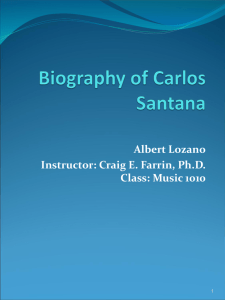guitar heaven
advertisement
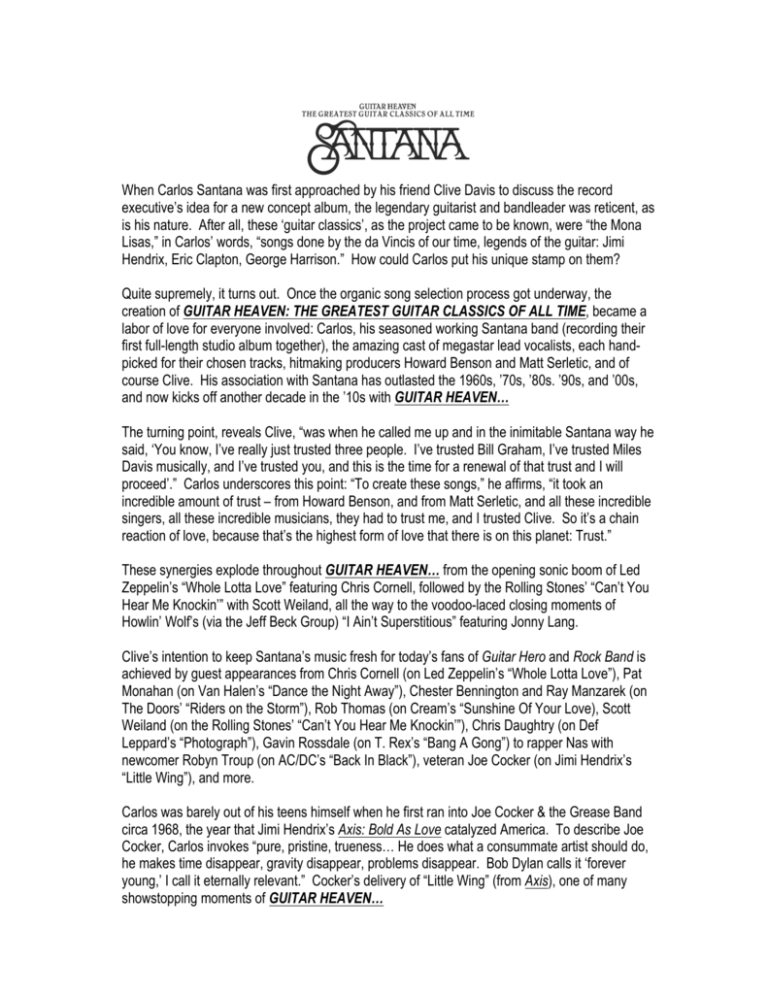
When Carlos Santana was first approached by his friend Clive Davis to discuss the record executive’s idea for a new concept album, the legendary guitarist and bandleader was reticent, as is his nature. After all, these ‘guitar classics’, as the project came to be known, were “the Mona Lisas,” in Carlos’ words, “songs done by the da Vincis of our time, legends of the guitar: Jimi Hendrix, Eric Clapton, George Harrison.” How could Carlos put his unique stamp on them? Quite supremely, it turns out. Once the organic song selection process got underway, the creation of GUITAR HEAVEN: THE GREATEST GUITAR CLASSICS OF ALL TIME, became a labor of love for everyone involved: Carlos, his seasoned working Santana band (recording their first full-length studio album together), the amazing cast of megastar lead vocalists, each handpicked for their chosen tracks, hitmaking producers Howard Benson and Matt Serletic, and of course Clive. His association with Santana has outlasted the 1960s, ’70s, ’80s. ’90s, and ’00s, and now kicks off another decade in the ’10s with GUITAR HEAVEN… The turning point, reveals Clive, “was when he called me up and in the inimitable Santana way he said, ‘You know, I’ve really just trusted three people. I’ve trusted Bill Graham, I’ve trusted Miles Davis musically, and I’ve trusted you, and this is the time for a renewal of that trust and I will proceed’.” Carlos underscores this point: “To create these songs,” he affirms, “it took an incredible amount of trust – from Howard Benson, and from Matt Serletic, and all these incredible singers, all these incredible musicians, they had to trust me, and I trusted Clive. So it’s a chain reaction of love, because that’s the highest form of love that there is on this planet: Trust.” These synergies explode throughout GUITAR HEAVEN… from the opening sonic boom of Led Zeppelin’s “Whole Lotta Love” featuring Chris Cornell, followed by the Rolling Stones’ “Can’t You Hear Me Knockin’” with Scott Weiland, all the way to the voodoo-laced closing moments of Howlin’ Wolf’s (via the Jeff Beck Group) “I Ain’t Superstitious” featuring Jonny Lang. Clive’s intention to keep Santana’s music fresh for today’s fans of Guitar Hero and Rock Band is achieved by guest appearances from Chris Cornell (on Led Zeppelin’s “Whole Lotta Love”), Pat Monahan (on Van Halen’s “Dance the Night Away”), Chester Bennington and Ray Manzarek (on The Doors’ “Riders on the Storm”), Rob Thomas (on Cream’s “Sunshine Of Your Love), Scott Weiland (on the Rolling Stones’ “Can’t You Hear Me Knockin’”), Chris Daughtry (on Def Leppard’s “Photograph”), Gavin Rossdale (on T. Rex’s “Bang A Gong”) to rapper Nas with newcomer Robyn Troup (on AC/DC’s “Back In Black”), veteran Joe Cocker (on Jimi Hendrix’s “Little Wing”), and more. Carlos was barely out of his teens himself when he first ran into Joe Cocker & the Grease Band circa 1968, the year that Jimi Hendrix’s Axis: Bold As Love catalyzed America. To describe Joe Cocker, Carlos invokes “pure, pristine, trueness… He does what a consummate artist should do, he makes time disappear, gravity disappear, problems disappear. Bob Dylan calls it ‘forever young,’ I call it eternally relevant.” Cocker’s delivery of “Little Wing” (from Axis), one of many showstopping moments of GUITAR HEAVEN… Another inspired pairing features singer India.Arie and master cellist Yo-Yo Ma on George Harrison’s “While My Guitar Gently Weeps,” the first single pick from GUITAR HEAVEN… “Listening to the song,” Olivia Harrison told Carlos, “it made me jump for joy and cry at the same time… George understood your passion for compassion.” Carlos adds, “Spirituality to me is Mother Theresa, the Dalai Lama and Desmond Tutu, Malcolm X, Marvin Gaye, Jimi Hendrix, Stevie Wonder, Andre Agassi, Clive, all of us do what we do because there is no greater joy than to be of service to humanity.” In addition to the vocal roster, Carlos offers “supreme validation and compliment” to his full-time band for their work on GUITAR HEAVEN… Band members who join him on the album include Dennis Chambers (drums), Benny Rietveld (bass), Karl Perrazo (timbales), Tommy Anthony (rhythm guitar), Freddie Ravel (keyboards), Andy Vargas (background vocals), and Raul Rekow (Congas). Bill Ortiz (trumpet) and Jeff Cressman (trombone) also appear on the record. There are many reasons why the songs on GUITAR HEAVEN… are so close to the heart for Carlos Santana, but the deepest connection is that so much of the music resonates within his own life and times. 1972’s “Bang A Gong,” for example, takes him right back to his years living as a vegetarian at Sri Chinmoy’s ashram in Jamaica, Queens, strolling down Parsons Boulevard while eating an eggplant hero, and hearing the T. Rex song blasting from a storefront. “Riders On the Storm” evokes the memory of buying snakeskin boots at a store in London at the height of the Sex Pistols punk rock era. “But this store still played the Doors, loud, and it sounded like Bitches Brew, it sounded like Miles. Man, what is this? I’d heard the Doors before, but the way I heard it there… when I played the song, it took me right back to that place.” # # # GUITAR HEAVEN: THE GREATEST GUITAR CLASSICS OF ALL TIME is the fourth chapter in a new-old rock saga, whose roots stretch back to 1997, when Clive Davis attended his first Santana concert in some years, at New York’s Radio City Music Hall. (The year before, in 1996, Santana had received the prestigious Billboard Century Award.) Clive originally signed Santana to Columbia Records in 1968, and oversaw the band’s formative years on the path to international superstardom starting in 1969. In the ’70s, their paths diverged, but nearly three decades later, the chemistry between them was as strong as ever. When Clive heard Carlos emotionally confess that his teenage children did not hear Santana on their favorite radio stations, Clive’s mission on behalf of his old friend became clear. It took two years to develop the album – in the interim, Santana was inducted into the Rock And Roll Hall Of Fame in 1998. When Supernatural was released in 1999, it was the beginning of an industry phenom, 15-times RIAA platinum in the U.S. alone, nearly double that number of sales globally, the #6 best-selling album in SoundScan history. Supernatural spent 102 weeks on the Billboard chart including 12 weeks at #1. Its success was fueled by the #1 singles “Smooth” (12 weeks at #1, co-written by and featuring Rob Thomas of Matchbox Twenty) and “Maria Maria” (10 weeks at #1, featuring Product G&B). Indeed, the Santana kids were now hearing their dad on the radio, big time. Supernatural generated nine GRAMMY awards, an all-time record for a single album project, including Album Of the Year and Best Rock Album, as well as Record Of the Year, Song of the Year, and Best Pop Collaboration, all for “Smooth”; plus Best Pop Performance by a Duo/Group for “Maria Maria”; Best Rock Performance by a Duo/Group for “Put Your Lights On” (featuring Everlast); Best Rock Instrumental Performance for “The Calling” (featuring Eric Clapton); and Best Pop Instrumental Performance (“El Farol”) There were also premiere Latin GRAMMY Award wins (the show’s first year) for Record Of The Year and Best Rock Performance by a Duo/Group for “Corazon Espinado” (featuring Maná). Supernatural was a hard act to follow – but 2002’s Shaman gave Santana a second consecutive #1 multi-platinum album, propelled by the GRAMMY-winning Top 5 single “The Game of Love” featuring Michelle Branch; and Top 10 “Why Don’t You and I” with Chad Kroeger of Nickelback. The album also featured collaborations with Dido, Citizen Cope, Placido Domingo, Macy Gray, Alejandro Lerner, Musiq, Ozomatli, P.O.D., and Seal. Third in this series of collaborative albums was 2005’s All That I Am, which entered SoundScan at #2, led by the anthemic rocker “Just Feel Better,” featuring Steven Tyler of Aerosmith. Other collaborators included Big Boi of OutKast and Mary J. Blige (on “My Man”), will.i.am of the Black Eyed Peas (on “I Am Somebody”), Joss Stone and Sean Paul (on “Cry Baby Cry”), Michelle Branch, Raphael Saadiq of Tony! Toni! Tone! and the Wreckers (all on “I’m Feeling You”), plus Anthony Hamilton, Kirk Hammett & Robert Randolph, Bo Bice, and Los Lonely Boys. This quartet of albums – Supernatural, Shaman, All That I Am, and now GUITAR HEAVEN… – stands alone in the annals of rock history. More than a decade after they renewed their association, the working partnership of Carlos Santana and Clive Davis continues to thrive and build upon its success. To call their partnership unique in the music industry is an understatement. “Carlos has a very strong inner sense of what is right for him,” observes Clive. “He listens with an ear for the music but he also listens knowing, can this song be right for Santana? Can he make it his own? Does he feel that this came to him fresh? I want Carlos to flower as he felt it and as he saw it. That was very important to me, just let it flow.” # # # Long before “world music” was a destination at search engines across the globe – or was even a genre, for that matter – Carlos Santana and the band that bears his name were laying down the tracks that would bring homegrown electric American music to the four corners of the earth. In turn, the music ricocheted back to our shores, filtered through the musical waterfalls of Afro-pop and Afro-beat, Caribbean voodoo-rock, and a dozen geopolitical musical zones that now regard Santana as one of their own. Carlos Humberto Santana de Barragan came from the humblest of backgrounds. He was born 1947, in Autlan de Navarro, Jalisco, Mexico (where a street and public square now bear his name). His father, a virtuoso mariachi violinist, instilled a musical spirit in his son who also began playing violin at age five. Later, when the family moved north to the bustling border town of Tijuana, Carlos took up the guitar and began to absorb his first influences. Listening to the powerful American radio stations whose signals reached into Mexico, he fell under the spell of John Lee Hooker, T. Bone Walker, and B.B. King, a trinity of guitar heroes whose styles blurred the lines of blues and jazz. By age 14, his family had moved to San Francisco, where Carlos graduated high school in 1965. He soon began talking his way into shows promoted by Bill Graham and others at the Fillmore, Winterland, and Avalon ballrooms. It was an eclectic crash course in Muddy Waters, Mongo Santamaria, British rock, and the first wave of first generation Bay Area bands whose members were all just a few years older than him: Jefferson Airplane, Big Brother & the Holding Company, Grateful Dead, Quicksilver Messenger Service. The Santana Blues Band was formed in 1966, its name owed to some fine print in the San Francisco musicians union contract that one person be named the leader, though everyone thought of it as a collective. The band’s heady concoction of West Coast soul, Latin percussion, groovy organ, and Carlos’ stratospheric lead guitar was an immediate sensation. By 1967, they were known simply as Santana. They eventually came to the attention of Graham, who booked them for the first time in October at the Fillmore West on a bill with The Who, in their first appearance at the hall. As an opening act over the course of the next year, Santana gained a reputation for captivating and winning audiences – some would say stealing the show – no matter who the headliner was. At Graham’s personal request, Clive Davis flew out to San Francisco over Christmas week 1968, witnessed the Santana experience first hand, and signed the band to Columbia Records. The band’s first Columbia recording sessions took place in January 1969. After a lineup shift, new sessions took place in May for what became the landmark Santana debut album. The LP release was aptly scheduled – for Monday, August 18, 1969, following their historic Saturday afternoon performance at the Woodstock Music & Art Fair (the only major act to play the festival before their debut album had been released). When Top 40 radio discovered “Evil Ways” in early 1970, the album jumped to #4, on its way to double-platinum and the #150 spot on Rolling Stone magazine’s 500 Greatest Albums list. The debut’s success was eclipsed at the end of 1970, when “Oye Como Va” and “Black Magic Woman” sent Abraxas to #1 for 6 weeks; the Grammy Hall Of Fame album has sold more than 5 million copies to date in the U.S. alone. With “Everybody’s Everything” and “No One To Depend On” again reaching the Top 40, 1971’s Santana III spent 5 weeks at #1 and brought a third consecutive multi-platinum award. In many ways, the band’s career is bookended by Santana, Abraxas and Santana III on one end of the timeline and – three decades later – Supernatural, Shaman and All That I Am, and now Guitar Heaven… at the other end of the timeline. The myriad adventures in between have been chronicled in more books than there are original studio and live albums in the official Santana catalogue (more than 35 titles to date on the Columbia, Columbia/Legacy, Polydor, and Arista labels). In October 2007, Ultimate Santana was released, the most recent anthology – and the first to include touchstone tracks from the band’s early years on Columbia Records alongside the groundbreaking collaborations that highlight the Arista years. To date, it is the only place to find “Evil Ways,” “Oye Como Va,” “Black Magic Woman,” “Samba Pa Ti,” “Everybody’s Everything,” and “No One To Depend On” – and “Smooth,” “Maria Maria,” “Put Your Lights On,” “Corazon Espinado,” “The Game of Love,” and “Just Feel Better” (plus other selections) in one package. Two years later in 2009, the Supernatural: Legacy Edition double-CD was issued, featuring a newly remastered version of the album (for the first time in ten years), plus a second CD of outtakes, remixes and unreleased material from the original recording sessions. The arc of Santana’s performing and recording career is complemented by a lifelong devotion to social activism and humanitarian causes. The Milagro Foundation was launched in 1998, the culmination of decades of support for countless charities and non-profit agencies the world over. With more than $4 million in grants to date, Milagro supports organizations promoting the welfare of underserved children in the areas of health, education, and the arts. Carlos also become deeply involved in the fight against the AIDS pandemic in South Africa, through a partnership with ANSA – Artists for New South Africa. In fact, all of the proceeds from Santana's 2003 American tour were donated to the cause. Other organizations championed by Santana include Hispanic Education and Media Group, Doctors Without Borders, Save the Children, Childreach, Rainforest Action Network, Greenpeace, American Indian College Fund, Amnesty International, and the Los Angeles-based Museum of Tolerance. Carlos' influence and idealism is also felt in the groundbreaking project Architects of a New Dawn (www.aoand.com), a multi-platform media enterprise and social network designed to empower like-minded people from all walks of life to create positive change in the global community. The project grew out of a vision Carlos has to engage his worldwide audience with extraordinary music, progressive media content and transformational ideas. AOND is architecting a new reality for the planet based on inspiration, creativity, love and forgiveness. After more than 40 years on the world stage, Carlos Santana is at the pinnacle of his career, more vital and relevant – and more exposed on radio, TV and the Internet – than ever before. His passionate “old school” virtuosity and “new school” cool attract the hippest artists to every new recording project that he and Clive Davis initiate. At the essence is a signature sound that is unique and instantly identifiable. With his lifetime of achievement and dedication to music, every move that Santana makes is a multi-cultural event – the soundtrack for the world. In May 2009, Santana became the first act to hold a residency at the spectacular, newlyexpanded Joint at the Hard Rock Hotel & Casino in Las Vegas. Supernatural Santana: A Trip Through The Hits is a musical retrospective running for 72 performances over 2009-2010. (In August 2010, a special GUITAR HEAVEN… launch event took place at The Joint, bringing together many of the album’s participants including India.Arie, Gavin Rossdale, and Chris Daughtry for a live concert event.) The idea of a residency in Las Vegas represents a sea change for Carlos, who is on a personal campaign over the last two or three years, “to do everything that I said I would never do. So this year, I am committed to learn how to cook bouillabaisse, snorkel, and body surf. My whole life is entering a place with no fear. Replace fear with possibilities and opportunities. GUITAR HEAVEN…, when people listen to it, they will be transported into a place beyond what they knew, and to a new place where even my brothers and friends like Eric Clapton, Jimmy Page, and Jeff Beck will celebrate, that we are honoring them.” “I feel really happy,” Carlos concludes, “I am more happy than I have ever been in my life because I am grateful. I am grateful for Clive, I am grateful for Michael Lang and Bill Graham and people who opened doors. Woodstock was a door, Supernatural was a door. Everyone who I ever met, Miles Davis or Tito Puente or B.B. King, all of them have gone out of their way to help me keep going. I have some great teachers, and some of them are my students too. We hope to touch many, many people’s hearts with GUITAR HEAVEN… It’s like Olivia said, our goal is to make people jump with joy and cry at the same time.” (September 2010)
